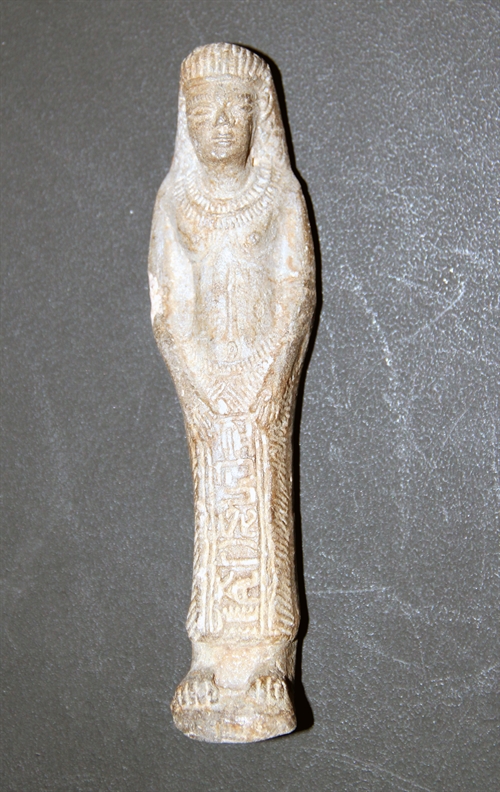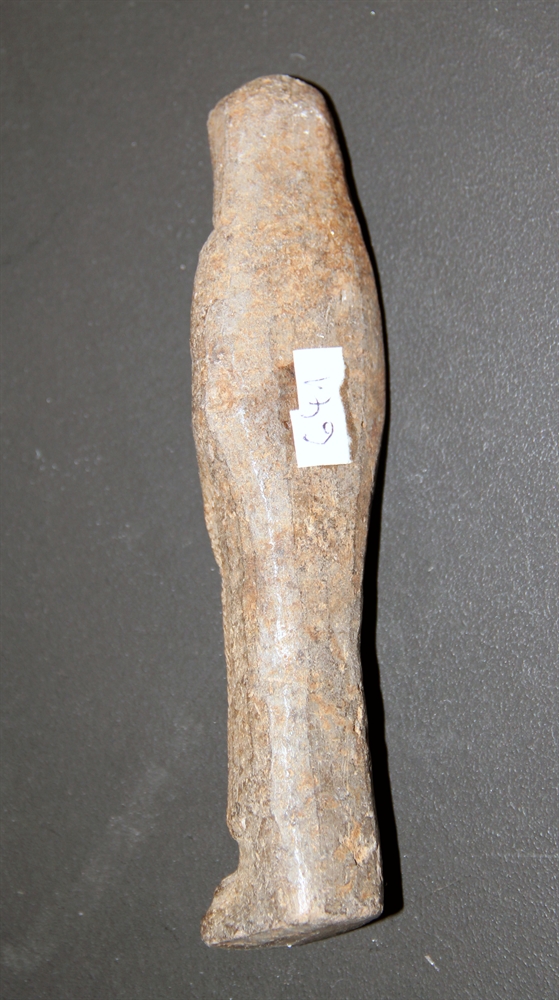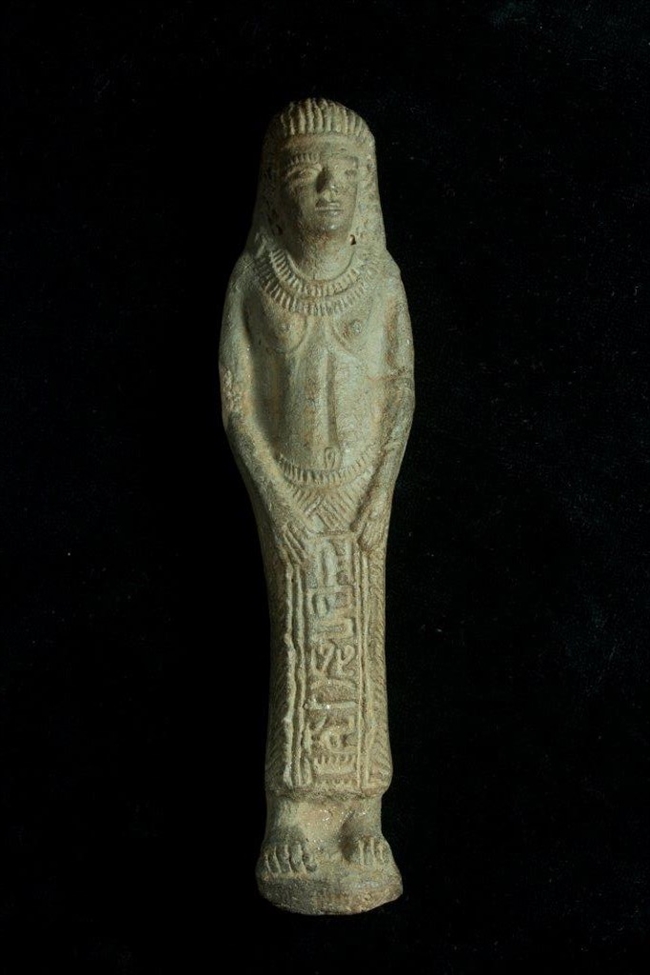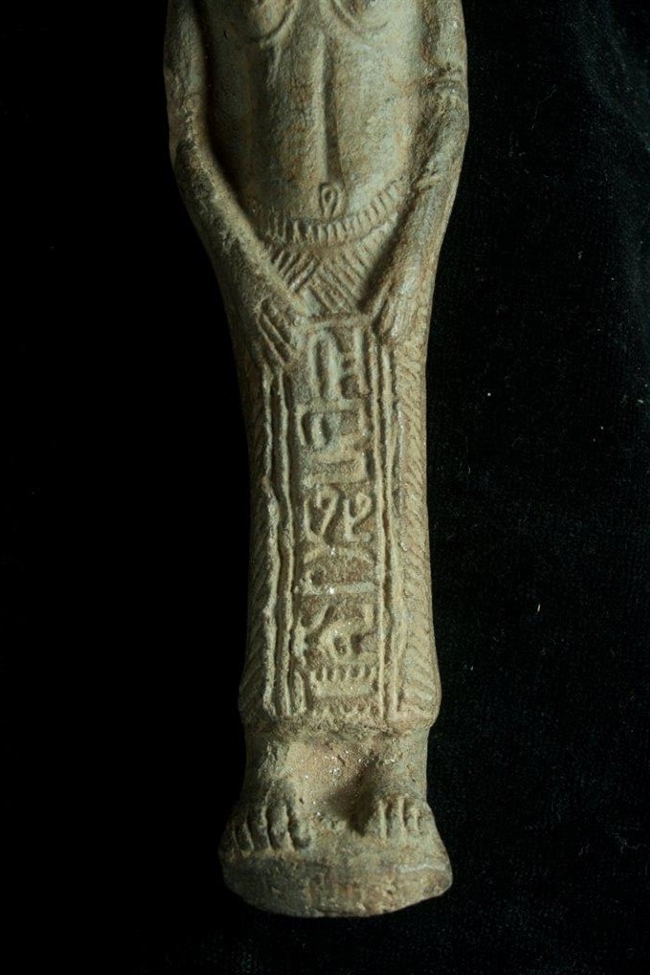Pseudoshabti

Female pseudoshabti figurine with naked breasts. The striated lappet wig with flat back. Without beard. Collar around neck. Naked arms with hands on skirt in attitude of praying. Without implements, bags and baskets. Face is oval and well-shaped. Eyes with brows. Ears are well shaped. Pseudo hieroglyphic inscription in one vertical column is carved on skirt above naked feet. Typical features of the everyday life shabtis from the New Kingdom.
The almost identical pseudoshabti is kept today in Syracuse. It supposed to be discovered in Biggemi before 1935 when it was firstly mentioned in the museum inventory books. E. Hauslauer analysed it and wrote that it is modern “fake” probably made at the end of the 19th or at the beginning of the 20th century. (Hauslauer 2006, 42) Hauslauer also thinks that similar shabtis from New York and Vienna are modern “fakes” (Hauslauer 2006, 42-43) because of the pseudo hieroglyphic text. This opinion is doubtful for the two reasons: 1) this identical pseudoshabti from Krk was discovered in archaeological context which means that it original and not modern product; 2) the false hieroglyphic signs do not have to prove that such shabtis are fakes. If such shabtis were crafted outside Egypt in Sicily and North Africa they are probably connected with some workshops related with ancient Egyptian cults and those artists probably do not know ancient Egyptian language and hieroglyphic signs. Such artefacts were probably sold all over Mediterranean world in ancient times and region of Syracuse with good trade connection with Mediterranean east and Egypt could easily be one of the centres for distribution of these kind of goods.
According to the information given by the archaeologist Ranko Starac from Pomorski i povijesni muzej Hrvatskog primorja in Rijeka, who wrote to me about these artefacts, they were discovered in a late Hellenistic grave which were dated to the middle of the 1st century B.C. These graves were excavated in the backyard of the house Šinigoj in the city of Krk.
According to the archaeological context of the surrounding artefacts discovered Ancient Egyptian artefacts (shabti, pseudoshabti, and three scarabs) should be dated in the middle of the First century B.C., most likely to the period of the civil war between Pompey and Julius Caesar, probably in 49 B.C. or during the second half of the 1st century B.C.
In early 49 B.C. Julius Caesar ordered Publius Cornelius Dolabella to build fleet in Adriatic (App. Civ. II.41), and the part of this fleet was stationed in Curicum under command of Gaius Antonius (App. Civ. II.41), probably the brother of Marcus Antonius. At the same time Pompey fleet under the command of Marcus Octavius and Lucius Scribonius Libo was stationed at Issa, and sent to the north Adriatic. After the famous battle at Krk, in the middle of 49 B.C., the fleet of Gaius Antonius was defeated, and he had to surrender to Marcus Octavius troops who took charge of Curicum. (App. Civ. II.47; D. C. XLI.40-411-2)
It is known that the part of the Pompey fleet and military forces which defeated Gaius Antonius near Krk were recruited in Liburnia, Aegean region and Egypt. (Veith 1924; Šišić 1925: 93-94; Matijašić 2009: 129-131) It is very likely that few soldiers or sailors who died during the early years of civil war (49-48 B.C.) were buried in these late Hellenistic graves discovered at the backyard of the house Šinigoj, along with Egyptian artefacts which they could brought directly from Egypt or from some unknown location in the Eastern Mediterranean or maybe even Sicily. We cannot confirm or deny if they were worshippers of Egyptian divinities, but that option is also possible. If these artefacts were really delivered to Krk in the middle of the First century B.C. we have a final proof of much earlier penetration of the Ancient Egyptian artefacts at the east Adriatic coast. According my previous thesis many of the previously not dated genuine Ancient Egyptian artefacts which were discovered along the coast of the east Adriatic probably were brought there during the First Millennium B.C. (c. 7th-1st century B.C.) and not during the period from the 1st to the early 4th century A.D. This hypothesis is based on the iconographical and typological study of such artefacts (amulets, shabtis, and statuettes of gods). (Tomorad 2015: 167-198) P. Selem also mentioned that possibility in couple of his articles in the late 1960s and early 1970s but without any in-depth analysis.
The almost identical pseudoshabti is kept today in Syracuse. It supposed to be discovered in Biggemi before 1935 when it was firstly mentioned in the museum inventory books. E. Hauslauer analysed it and wrote that it is modern “fake” probably made at the end of the 19th or at the beginning of the 20th century. (Hauslauer 2006, 42) Hauslauer also thinks that similar shabtis from New York and Vienna are modern “fakes” (Hauslauer 2006, 42-43) because of the pseudo hieroglyphic text. This opinion is doubtful for the two reasons: 1) this identical pseudoshabti from Krk was discovered in archaeological context which means that it original and not modern product; 2) the false hieroglyphic signs do not have to prove that such shabtis are fakes. If such shabtis were crafted outside Egypt in Sicily and North Africa they are probably connected with some workshops related with ancient Egyptian cults and those artists probably do not know ancient Egyptian language and hieroglyphic signs. Such artefacts were probably sold all over Mediterranean world in ancient times and region of Syracuse with good trade connection with Mediterranean east and Egypt could easily be one of the centres for distribution of these kind of goods.
According to the information given by the archaeologist Ranko Starac from Pomorski i povijesni muzej Hrvatskog primorja in Rijeka, who wrote to me about these artefacts, they were discovered in a late Hellenistic grave which were dated to the middle of the 1st century B.C. These graves were excavated in the backyard of the house Šinigoj in the city of Krk.
According to the archaeological context of the surrounding artefacts discovered Ancient Egyptian artefacts (shabti, pseudoshabti, and three scarabs) should be dated in the middle of the First century B.C., most likely to the period of the civil war between Pompey and Julius Caesar, probably in 49 B.C. or during the second half of the 1st century B.C.
In early 49 B.C. Julius Caesar ordered Publius Cornelius Dolabella to build fleet in Adriatic (App. Civ. II.41), and the part of this fleet was stationed in Curicum under command of Gaius Antonius (App. Civ. II.41), probably the brother of Marcus Antonius. At the same time Pompey fleet under the command of Marcus Octavius and Lucius Scribonius Libo was stationed at Issa, and sent to the north Adriatic. After the famous battle at Krk, in the middle of 49 B.C., the fleet of Gaius Antonius was defeated, and he had to surrender to Marcus Octavius troops who took charge of Curicum. (App. Civ. II.47; D. C. XLI.40-411-2)
It is known that the part of the Pompey fleet and military forces which defeated Gaius Antonius near Krk were recruited in Liburnia, Aegean region and Egypt. (Veith 1924; Šišić 1925: 93-94; Matijašić 2009: 129-131) It is very likely that few soldiers or sailors who died during the early years of civil war (49-48 B.C.) were buried in these late Hellenistic graves discovered at the backyard of the house Šinigoj, along with Egyptian artefacts which they could brought directly from Egypt or from some unknown location in the Eastern Mediterranean or maybe even Sicily. We cannot confirm or deny if they were worshippers of Egyptian divinities, but that option is also possible. If these artefacts were really delivered to Krk in the middle of the First century B.C. we have a final proof of much earlier penetration of the Ancient Egyptian artefacts at the east Adriatic coast. According my previous thesis many of the previously not dated genuine Ancient Egyptian artefacts which were discovered along the coast of the east Adriatic probably were brought there during the First Millennium B.C. (c. 7th-1st century B.C.) and not during the period from the 1st to the early 4th century A.D. This hypothesis is based on the iconographical and typological study of such artefacts (amulets, shabtis, and statuettes of gods). (Tomorad 2015: 167-198) P. Selem also mentioned that possibility in couple of his articles in the late 1960s and early 1970s but without any in-depth analysis.
Catalogue entry
Pseudoshabti
Franciscan Monastery, Košljun
Archaeological collection
Inv. no. 641
Krk (Curicum), date unknown
Ptolemaic period (306-30 B.C.)
terracotta: baked earth, carving
15.4 x 5.2 cm
Typology: Tomorad, class J
Cf. private collection, New York; Museo Archeologico Regionale “P. Orsi”, Siracusa: 47425; Kunsthistorisches Museum, Vienna: 6708.
Resources
- Tomorad, Mladen. "Shabtis from the Museum and Private Collections in Croatia: Dating and Typological Study". U: Tomorad, Mladen; Popielska-Grzybowska, Joanna (ur.). Egypt 2015: Perspectives of Research - Proceedings of the Seventh European Conference of Egyptologists (2nd-7th June 2015, Zagreb, Croatia). Oxford, 2017: 219-240. 220, 224, 237.
- Tomorad, Mladen. „The Ancient Egyptian Antiquities in Institutional and Private Collections in Croatia“. U: Tomorad, Mladen (ur.). A History of Research into Ancient Egyptian Culture conducted in Southeast Europe. Oxford, 2015: 31-58. 51.
- Tomorad, Mladen. „The Ancient Egyptian Collections in Croatia and the Project Croato-Aegyptica Electronica“. U: Derriks, Claire (ur.). Collections at risk: New Challenges in a New Environment - Proceedings of the 29th CIPEG Annual Meeting in Brussels, September 25-28, 2012, Royal Museums of Art and History Brussels, Belgium. Atlanta, 2017: 237-268. 260, fn. 87.
- Tomorad, Mladen. „The Early Penetration of Ancient Egyptian Artifacts and Dissemination of the Cults of Egyptian Divinities in Istria and Illyricum (1st Millennium B.C.-1st Century A.D.)“. U: Tomorad, Mladen (ur.). A History of Research into Ancient Egyptian Culture conducted in Southeast Europe. Oxford, 2015: 165-200. 186, no. 12, 189-190, fig. 135.
- Tomorad, Mladen. „The phases of penetration and diffusion of Egyptian artefacts and cults in the region of Istria and Illyricum (from the 7th c. B.C. to the 4th c. A.D.)“. U: Györy, Hedvig (ur.). Aegyptus et Pannonia V. Budapest, 2016: 185-226 + Plates 69-81. 196-197, 203-204, Pl. 72.
- Tomorad, Mladen. „The Two Unpublished Shabtis from Krk (Croatia)“. The Journal of Egyptological Studies IV (2015): 141-146. no. 2.2, 144-145.
- Tomorad, Mladen. Staroegipatska civilizacija, sv. II: Uvod u egiptološke studije. Zagreb, 2017. 83.





